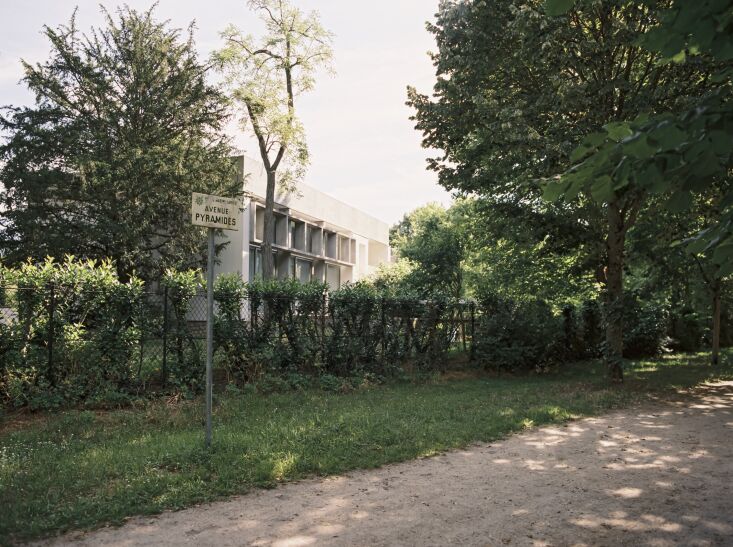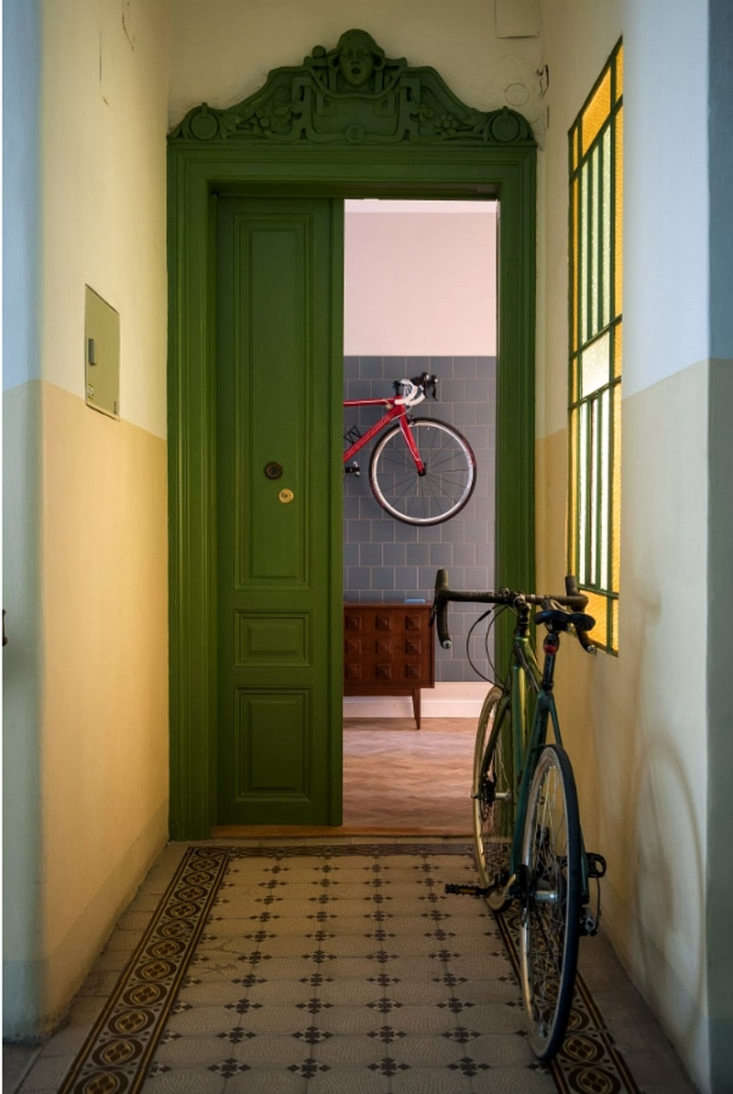When it comes to Parisian heritage restoration, architects Léa Cottreel and Rosalie Robert of RREEL are the latest studio du jour. With expertise in 19th and 20th century building construction (they both hold the DSA Architecture and Heritage from Énsa-PB in Paris), the restoration of the 1959 Maison Bernard from Edith Schreiber-Aujame was the perfect match for RREEL. Franco-American architect Edith Schreiber-Aujame was born in Poland but lived in France after studying under Walter Gropius and Marcel Breuer and working under the the direction of Vladimir Bodiansky and Charlotte Perriand in the studio Le Corbusier in 1947. (She also was responsible, in part, for the details on Le Corbusier’s Cité Radieuse in Marseille.) The house, a villa located in Maisons-Laffitte, France, is characteristic of the villas of the 1950s, with an organic influence of Le Corbusier and Charlotte Perriand.
The clients, a young couple looking to start a family, wanted to paint and modify the bathroom and kitchen before moving in. They asked another architect who, after seeing the house, referred them to RREEL: “It was obvious that the property was no ordinary house,” says Rosalie.
Rather than beginning work straight away, Rosalie and Léa suggested a period of research into the house and its architect in the archives. As they dove into the research, they uncovered more and more about Schreiber-Aujame and her original concept for the villa. The house had been modified in the early 2000s with a terrace replaced by a bedroom and the fireplace replaced with a stove. The clients’ aim was to gradually restore the house to its original state phased over several years. RREEL begin by restoring the kitchen and opening it into the living room, as well as restoring the fireplace, bathroom, and staircase as well as the built-in furniture original to the house. Join us for a look around.
Photography by Mary Gaudin for RREEL.
Above: The house is located in the forested region of Maisons-Laffitte, a 30 minute train ride northeast of Paris.
 Above: An exterior view of the 260-square-meter concrete and glass building.
Above: An exterior view of the 260-square-meter concrete and glass building.
 Above: “Many of the details of the house are evocative of Le Corbusier’s Brutalist period: the sunbreakers, the cast concrete, and the cap suspended over the entrance,” the architects explain.
Above: “Many of the details of the house are evocative of Le Corbusier’s Brutalist period: the sunbreakers, the cast concrete, and the cap suspended over the entrance,” the architects explain.
 Above: The architects restored the fireplace the living room. The marble floors, all original stonework, were intensively cleaned and polished.
Above: The architects restored the fireplace the living room. The marble floors, all original stonework, were intensively cleaned and polished.
 Above: The floor-to-ceiling curtain offering privacy to the main living area was already in place in the interior.
Above: The floor-to-ceiling curtain offering privacy to the main living area was already in place in the interior.
 Above: “The clients wanted an open kitchen. We suggested that they keep the existing kitchen, but remove the doors and create an opening in the wooden cabinet. This passe-plat [serving hatch] can be opened to allow the dining room and kitchen to communicate, or can be closed to restore the original design,” says Rosalie. “It’s a compromise between contemporary living and heritage conservation.”
Above: “The clients wanted an open kitchen. We suggested that they keep the existing kitchen, but remove the doors and create an opening in the wooden cabinet. This passe-plat [serving hatch] can be opened to allow the dining room and kitchen to communicate, or can be closed to restore the original design,” says Rosalie. “It’s a compromise between contemporary living and heritage conservation.”
 Above: The colored tiles are from Edith Schreiber-Aujame’s design. The white tiles are old Villeroy & Boch, no longer manufactured. The range is an Italian Lofra model and the range hood was fabricated custom by the architects, inspired by Schreiber-Aujame’s fireplace design. RREEL replaced the old faucet with a utilitarian model from RVB in Belgium.
Above: The colored tiles are from Edith Schreiber-Aujame’s design. The white tiles are old Villeroy & Boch, no longer manufactured. The range is an Italian Lofra model and the range hood was fabricated custom by the architects, inspired by Schreiber-Aujame’s fireplace design. RREEL replaced the old faucet with a utilitarian model from RVB in Belgium.
 Above: “We replaced the missing tiles and continued the worktops with Winckelmans tiles,” says Rosalie.
Above: “We replaced the missing tiles and continued the worktops with Winckelmans tiles,” says Rosalie.
 Above: The archives described “an exotic wood” as used in the cabinetry throughout the house. “When we did samples to try to imitate the material, we finally chose an oiled and stained oak.” In front of the original cabinets sits an Aalto Stool 60 in green lacquer.
Above: The archives described “an exotic wood” as used in the cabinetry throughout the house. “When we did samples to try to imitate the material, we finally chose an oiled and stained oak.” In front of the original cabinets sits an Aalto Stool 60 in green lacquer.
 Above: RREEL restored the staircase which consists of stone and concrete with metal and wood railings connecting three floors.
Above: RREEL restored the staircase which consists of stone and concrete with metal and wood railings connecting three floors.
 Above: A detail of the staircase.
Above: A detail of the staircase.
 Above: The built-in furniture in the bathroom, like all others, is original, as is the blue tile. The lamp is the Charlotte Perriand Pivotante À Poser Table Lamp in orange. The bathtub is a Villeroy & Boch O.Novo Bath and the bath taps are the TV15751 Triverde Thermostatic Faucet from Ondyna.
Above: The built-in furniture in the bathroom, like all others, is original, as is the blue tile. The lamp is the Charlotte Perriand Pivotante À Poser Table Lamp in orange. The bathtub is a Villeroy & Boch O.Novo Bath and the bath taps are the TV15751 Triverde Thermostatic Faucet from Ondyna.
 Above: Opposite the vanity is a mirror reflecting back into the bathroom shows a pair of TV22051 Triverde Faucets. The colored storage bins are the same design used by Charlotte Perriand in her projects. “Edith Schreiber-Aujame and Charlotte Perriand were great friends, so we think that Perriand helped Schreiber in a kind of way.”
Above: Opposite the vanity is a mirror reflecting back into the bathroom shows a pair of TV22051 Triverde Faucets. The colored storage bins are the same design used by Charlotte Perriand in her projects. “Edith Schreiber-Aujame and Charlotte Perriand were great friends, so we think that Perriand helped Schreiber in a kind of way.”
 Above: In the bedroom, the flooring is a rubber floor from Artigo, installed by RREEL. (They also utilized Artigo rubber floors in a Le Corbusier renovation; see our post A Poetic Echo: A Restored Apartment in Le Corbusier’s Molitor Building in Paris from RREEL.
Above: In the bedroom, the flooring is a rubber floor from Artigo, installed by RREEL. (They also utilized Artigo rubber floors in a Le Corbusier renovation; see our post A Poetic Echo: A Restored Apartment in Le Corbusier’s Molitor Building in Paris from RREEL.
 Above: The Applique À Volet Pivotant Wall Lights by Charlotte Perriand were an addition from RREEL.
Above: The Applique À Volet Pivotant Wall Lights by Charlotte Perriand were an addition from RREEL.
 Above: The curtains seen here were installed by the clients; a Salsa 4 Fabric from Camengo.
Above: The curtains seen here were installed by the clients; a Salsa 4 Fabric from Camengo.
 Above: A view from the rear looking into the living room.
Above: A view from the rear looking into the living room.
 Above: The Brutalist concrete patio extends into the yard.
Above: The Brutalist concrete patio extends into the yard.
 Above: An archival photograph from Fond Aujame of the house dated 1959.
Above: An archival photograph from Fond Aujame of the house dated 1959.
We’ve also profiled another historical renovation project by RREEL. See A Poetic Echo: A Restored Apartment in Le Corbusier’s Molitor Building in Paris from RREEL.
For more inspiring architecture in and around Paris, see our posts:
- A Considered Renovation in Old Versailles by Architect Saba Ghorbanalinejad
- Modernity in Outer Paris: A 1910 House in Île-de-France by Mudo Architecture
- Multiplying Light and Space: A Compact Paris Apartment with a Vintage Quality
- A Paris Apartment with Artful, Architectural Interventions from Corpus Studio
- Monastic Frivolity at Casey Casey’s Showroom and Atelier in Paris



